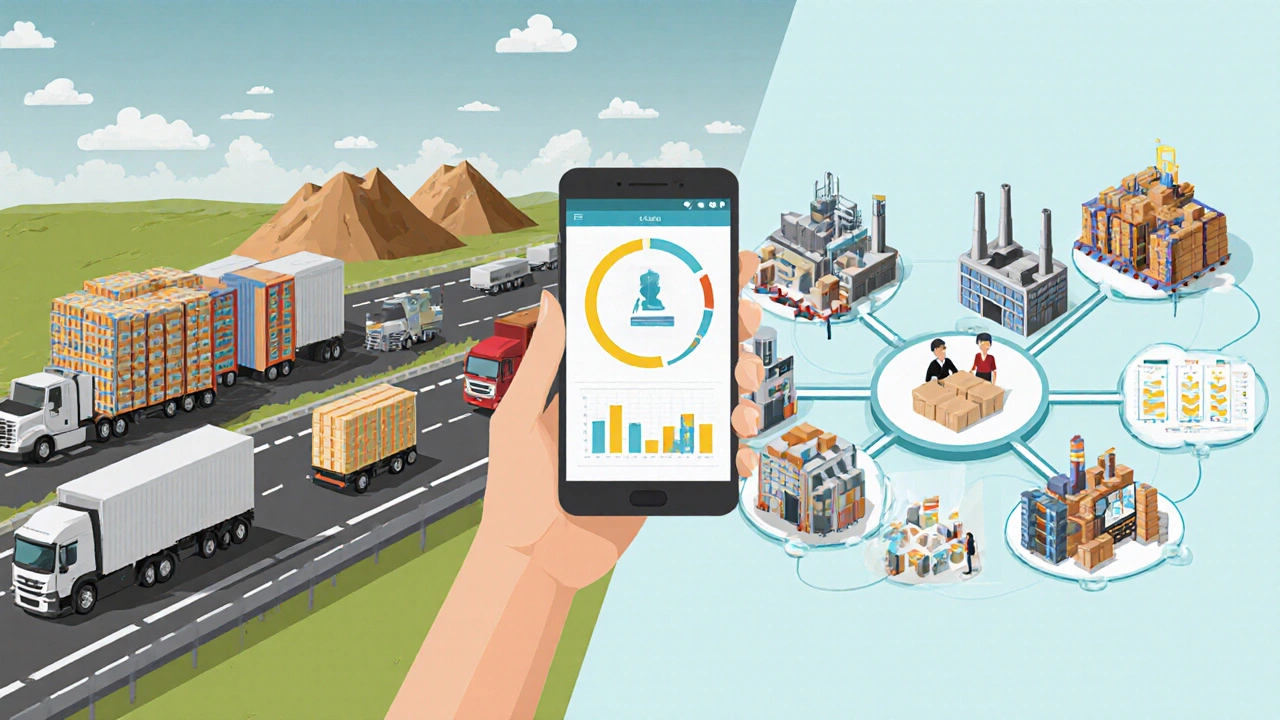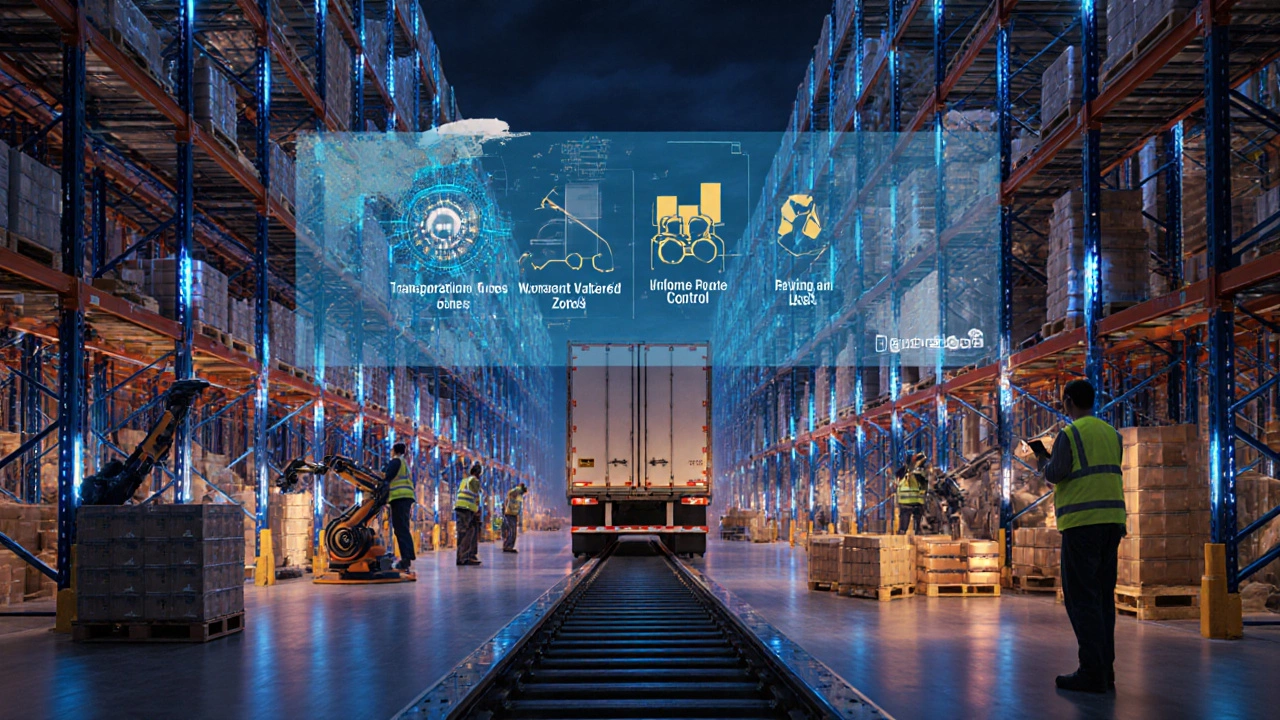Logistics vs Supply Chain: Which One Has the Bigger Scope?

Logistics vs Supply Chain Comparison Tool
Interactive Comparison
This tool compares the scope and key aspects of logistics versus supply chain management. Select an aspect below to see how the two concepts differ.
Visual Scope Comparison
The supply chain encompasses logistics as a subset. See how the scope differs:
Key Insight:
Logistics is a critical component of the supply chain, but the supply chain includes additional strategic elements such as procurement, production planning, demand forecasting, and customer relationship management. While logistics focuses on the physical movement and storage of goods, the supply chain encompasses the entire journey from raw materials to end customers.
Quick Takeaway
Logistics: Tactical execution of physical movement and storage of goods.
Supply Chain: Strategic end-to-end network including logistics plus procurement, production, demand planning, and customer relationship management.
When you hear people talk about moving products from a factory to a customer, you’ll often hear the words logistics vs supply chain tossed around as if they mean the same thing. In reality, they overlap a lot, but one of them actually covers a broader set of activities. This article breaks down exactly what each term means, how their scopes differ, and why the distinction matters for anyone running a business, studying operations, or just trying to make sense of today’s complex product flows.
What is Logistics?
Logistics is the planning, execution, and control of the movement and storage of goods, services, and related information from point of origin to point of consumption. Its core mission is to get the right product to the right place at the right time, at the lowest possible cost.
Key activities that fall under logistics include:
- Transportation - selecting modes (road, rail, sea, air) and managing carriers.
- Warehousing - receiving, storing, and retrieving inventory.
- Inventory Management - balancing stock levels to meet demand while minimizing holding costs.
- Order Fulfillment - picking, packing, and shipping customer orders.
- Reverse Logistics - handling returns, repairs, and recycling.
Because logistics directly touches the flow of physical goods, most people associate it with the day‑to‑day hustle of trucks on the road, pallets in a warehouse, and the software that tracks shipments.
What is a Supply Chain?
Supply Chain is the end‑to‑end network of organizations, people, activities, information, and resources involved in moving a product or service from raw material to final consumer. It encompasses everything that logistics does, but also the strategic steps that happen before a product even exists.
The broader supply chain includes:
- Procurement - sourcing raw materials, components, and services.
- Production Planning - converting raw materials into finished goods.
- Demand Planning - forecasting customer needs to drive production and inventory decisions.
- Supply Chain Management (SCM) - coordinating all network partners, from suppliers to distributors, to optimize overall performance.
- Customer Relationship Management - capturing feedback and managing after‑sales service.
In short, the supply chain is a strategic map of how value is created and delivered, while logistics is the tactical engine that moves the pieces along that map.
Scope Comparison: Who’s Bigger?
Because supply chain includes procurement, production, demand planning, and a host of other strategic functions, it is the larger umbrella. Logistics lives inside the supply chain, handling the physical movement part.
| Aspect | Logistics | Supply Chain |
|---|---|---|
| Primary Focus | Movement and storage of finished goods | Creation, flow, and delivery of value from raw material to consumer |
| Typical Activities | Transportation, warehousing, inventory control, order fulfillment | Procurement, product design, production planning, demand forecasting, logistics |
| Decision Horizon | Day‑to‑day operational decisions | Strategic, medium‑ and long‑term planning |
| Key Metrics | On‑time delivery, shipping cost per unit, inventory turnover | Cash‑to‑cash cycle, total supply chain cost, service level, net promoter score |
| Stakeholders | Warehouse managers, carrier partners, fulfillment teams | Suppliers, manufacturers, distributors, retailers, end customers |

Core Components of Logistics
Even though logistics is nested inside the larger supply chain, it still consists of several specialized parts that work together like a well‑tuned machine.
- Transportation Management - choosing the right carrier, route optimization, load consolidation, and real‑time tracking.
- Warehouse Management - receiving, put‑away, picking strategies (e.g., batch, wave, zone), and cross‑docking.
- Inventory Control - safety stock calculations, cycle counting, and ABC analysis.
- Order Processing - order entry, verification, and status communication.
- Reverse Logistics - handling returns, refurbishing, and disposal in an environmentally friendly way.
Each component can be powered by dedicated software (often called logistics management systems) that feeds data to higher‑level supply chain platforms.
Core Components of the Supply Chain
When you zoom out, the supply chain looks like a network of interconnected processes.
- Supplier Relationship Management - evaluating, onboarding, and collaborating with raw material providers.
- Product Development & Design - engineering the item with cost, manufacturability, and sustainability in mind.
- Production Planning & Scheduling - converting BOM (Bill of Materials) into work orders and shop‑floor schedules.
- Demand Forecasting & Planning - using historical sales, market trends, and promotional calendars to predict future need.
- Supply Chain Planning (SCP) - aligning production, inventory, and logistics to meet forecasted demand with minimal waste.
- Logistics Execution - the sub‑set of activities listed in the previous section.
- Customer Service & After‑sales - managing warranties, support tickets, and product returns.
These building blocks form a loop: demand informs production, production creates inventory, inventory fuels logistics, and logistics delivers to the customer, whose feedback restarts the cycle.
Where Do They Overlap?
Because logistics lives inside the supply chain, there’s a lot of shared terminology. For example, “distribution” can refer to the logistical act of moving finished goods to retailers, but it’s also a strategic decision within the supply chain about how many distribution centers to operate and where to locate them.
Both domains rely heavily on data - from transportation tracking numbers to demand forecasts - and both benefit from technology like IoT sensors, AI‑driven planning engines, and cloud‑based collaboration platforms.
In practice, many companies have a single “Supply Chain Organization” that houses a “Logistics Team.” The team focuses on execution, while the broader organization decides on network design, supplier selection, and long‑term risk mitigation.

Real‑World Examples
E‑commerce fulfillment: A retailer like Amazon operates a massive logistics network of fulfillment centers, sortation hubs, and last‑mile delivery fleets. The logistical side handles picking, packing, and delivering orders within hours. The supply‑chain side decides which products to stock where, how many regional warehouses to open, and how to negotiate with third‑party sellers.
Automotive manufacturing: A carmaker sources steel, electronics, and plastics from dozens of suppliers. The supply‑chain team plans production runs, aligns component deliveries with assembly line schedules, and manages supplier risk. Logistics then moves the parts from ports to factories and routes finished cars to dealers worldwide.
Pharmaceutical distribution: Regulations require temperature‑controlled storage and strict traceability. Supply‑chain planners choose which contract manufacturers to use, set batch release procedures, and forecast regional demand. Logistics teams ensure cold‑chain trucks keep vaccines at the right temperature from the factory to the clinic.
These scenarios show that the larger strategic picture (supply chain) dictates the boundaries and objectives of the day‑to‑day operational picture (logistics).
Why the Distinction Matters for Your Business
If you’re a small business owner, you might think “just get a good freight broker and you’re done.” That works for very simple product flows, but as you scale, ignoring the supply‑chain side can cost you dearly:
- Cost Leakage: Without demand planning, you’ll over‑stock, tie up cash, and pay extra warehousing fees.
- Service Failures: Poor supplier selection can lead to material shortages, causing missed delivery promises.
- Risk Exposure: A single‑source supplier might collapse; a robust supply‑chain strategy diversifies risk.
- Growth Limitation: Expanding into new markets needs network design - where to locate fulfillment centers, how to handle customs, etc.
Conversely, focusing only on strategic supply‑chain decisions without solid logistics execution will result in delayed shipments, inventory inaccuracies, and unhappy customers. The sweet spot is a tightly connected loop where data flows both ways: logistics reports real‑time performance back to supply‑chain planners, and planners adjust network settings based on that feedback.
Key Takeaways
- Logistics is a subset of the supply chain, dealing with the actual movement and storage of goods.
- The supply chain covers everything from raw‑material sourcing to after‑sales service.
- Both rely on data and technology, but their decision horizons differ - logistics is tactical, supply chain is strategic.
- Understanding the difference helps you allocate resources wisely and avoid costly blind spots.
Frequently Asked Questions
Is logistics part of supply chain management?
Yes. Logistics focuses on transporting and storing products, while supply chain management includes logistics plus procurement, production planning, demand forecasting, and more.
Can a company operate without a formal supply chain?
In theory a tiny business could handle sourcing, production, and delivery manually, but as volume grows the lack of a structured supply‑chain approach quickly leads to higher costs and lower service levels.
What metrics should I track for logistics?
Key logistics metrics include on‑time delivery rate, transportation cost per unit, inventory turnover, order cycle time, and reverse‑logistics cost percentage.
How does technology bridge logistics and supply chain?
Integrated platforms combine transportation‑management systems (TMS), warehouse‑management systems (WMS), and supply‑chain‑planning tools, allowing data from the shop floor to flow back to strategic planners in real time.
Which is more important for customer satisfaction: logistics or supply chain?
Both matter. A well‑designed supply chain ensures the right product is available, while efficient logistics delivers it quickly and accurately. The best companies excel at both.